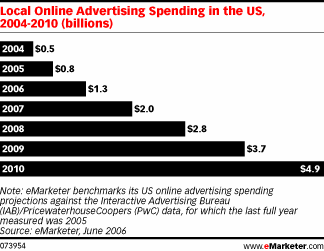
The promise of local online advertising, like some super-charged directory delivering motivated customers to the hundreds of thousands of small and mid-size businesses (SMBs) across America, is compelling.
The reality reminds us that smaller businesses, with smaller marketing budgets and smaller staffs to handle marketing chores, typically take longer to change than do large corporations.
In fact, U.S. local online ad spending will surpass the $1 billion mark for the first time only this year, according to eMarketer projections in a new report, "Local Online Advertising: Measuring the Potential." However, that spending figure will more than double to $2.8 billion in 2008, and will reach nearly $5 billion by 2010.
Where is all that growth going to come from? It's the newspaper and yellow-page publisher loses, primarily. Like taking candy from a baby, as they say.